QUOTE OF THE WEEK: “There is no such thing as a little freedom. Either you are all free, or you are not free.” ~ Walter Cronkite. Sadly at this point, we are not.
On Sunday, July 2, we headed over to Moose Creek Baptist Church in North Pole where we met a very nice group of people. The pastor, John Bills, had a very laid back, interactive teaching style that was different, but very comfortable. Afterwards we headed over to Pagoda Chinese Restaurant just down the road for some of the best Chinese food we’ve had in ages. They did a family style dinner that included soup, an appetizer plate, three entrees, and egg rolls. It was all delicious, and for around $60, we both ate at least FOUR meals! That’s a yummy deal right there!! Guy Fieri had also found this little gem, although it didn’t look like a diner, drive-in, or dive. After relaxing a bit at the campground, I headed back to the same plaza in North Pole to USA Nails for a much-needed pedicure. Don’t you love a nice, relaxing pedi? I do…usually. There were two guys working in the place when I arrived and one other client. I settled into the warm water and began to relax. Then one of the fellows started. He was very rough, shoving my cuticles back and clipping too close. He actually made one toe on each foot bleed! They do a wax treatment at the end, and that stuff was so hot I thought I’d have second degree burns on the bottom of my feet!! Thankfully, that wasn’t the case, but my body was MUCH more tense when I left than when I arrived. Not good!! Back at Petunia, I laid back and tried to discover my calm again. Didn’t do much else but a bit of writing in the evening.


You may remember I was disappointed at not seeing any Muskoxen up on the Dalton Highway last week. So on Monday, Mr. Wonderful (MW) took me to a place to get a close look…the University of Alaska Fairbanks Large Animal Research Station. This 130-acre facility was settled as a homestead in 1923, then donated to the university 40 years later by Mike Yankovich. (Wonder if he was Weird Al’s dad?) There I learned that, although they look a bit like Babe the Big Blue Ox, Muskoxen are actually more closely related to goats and sheep. They have amazing coats that have guard hairs on the outside and something called qiviut on the inside. The latter keeps them warm in the harsh Arctic winters and is naturally shed in the spring. A super soft, thin, and highly effective insulator, many people harvest it every year in the wild and spin it into a very fine yarn. Because it is hard to come by, the yarn costs about $120 per OUNCE! I felt a beanie woven from the stuff, which was almost as thin as a t-shirt, but I’m told is warmer than the big, thick wool ones. Both male and female muskox have horns that wrap around the tops of their heads, making them very odd looking. They serve a vital purpose for the males, though. Their skulls are about 3″ thick, then the horn is about 6″. That 3/4 of a foot protects their brains when they decide to fight for the females of the herd during rut. Two males will back up, face off, then run at each other at 35 mph (that’s a close rate of 70 mph) and have a literal, head-on collision. Eventually someone gives up and leaves the other to the harem. Just thinking about it makes my head hurt!! The young are born at about 20-25 pounds and males grow to about 850 pounds, while females top out at around 600 or so. The inside of their noses have these cool, spiral airways that help warm up the cold, Arctic air before it gets to their lungs. In Alaska, Muskox were once hunted to extinction, but were reintroduced with protection, and the numbers are growing. While we didn’t see any during our time in the Arctic, several of the other folks did.
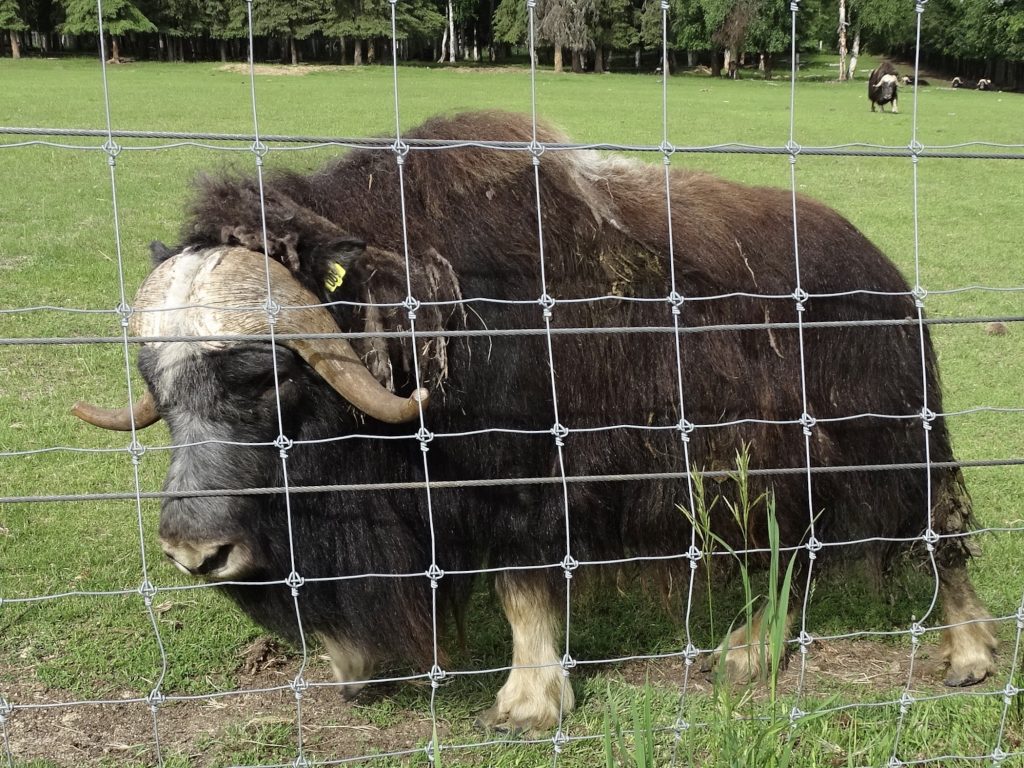






The other large animal the facility specializes in is reindeer. I said in a previous post that reindeer and caribou are the same species, but slightly different subspecies. The one that is native to Alaska is caribou, while reindeer are native to northern Eurasia. All domesticated versions worldwide are reindeer, and they are the only domesticated deer species. A few differences: Caribou migrate further than any other terrestrial mammal, while reindeer are more stationery. Both have large antlers, but reindeer’s are the largest and heaviest compared to their size. Reindeer have hair covering every part of their bodies, including their hooves and noses, making them suited for even the coldest climates. The two are so similar, however, that studying reindeer gives insight into the needs and behavior of caribou, too. The facility has a herd of 42





The final thing that was truly cool and unexpected were birds. As we were waiting for the tour to begin, we saw large cranes of some kind across the field where the Muskox were resting. A little bit later, we heard them. You may remember that, while visiting California last year, MW and I were noisily greeted by something that we couldn’t identify. Although we never saw them, we were later told that they were sandhill cranes nesting near the path, and they don’t particularly like anyone passing near. Well there were quite a few at the research station who come there every year on their own to nest. They are magnificent birds with a very loud, insistent call.



After finishing up with the animals, we stopped in at Fountainhead Antique Auto Museum. This is a pretty neat museum with lots of gorgeous cars. The displays are complimented with period fashions to give you a whole picture of the time. This pre-WWII private collection belongs to Tim Cerny of Fairbanks and has nearly 100 vehicles, with 75 or so on the floor at all times. There are rare finds, and one of a kinds, plus several of the earliest vehicles in Alaska including the actual very first car in the Territory. There are also several short films depicting life in Alaska when cars first came, and one about the 1933 motorcycle trip of Slim Williams and Jack Logan from Fairbanks to Seattle. Remember, the Alaska Highway wasn’t built until WWII. It was crazy, crossing rivers on downed trees, bouncing through fields, etc. The coolest thing about this museum, though, is that all but THREE of the cars actually drive and are taken motoring around the neighborhood during the summer. Wow! This is definitely worth a stop if you like cars or fashion.


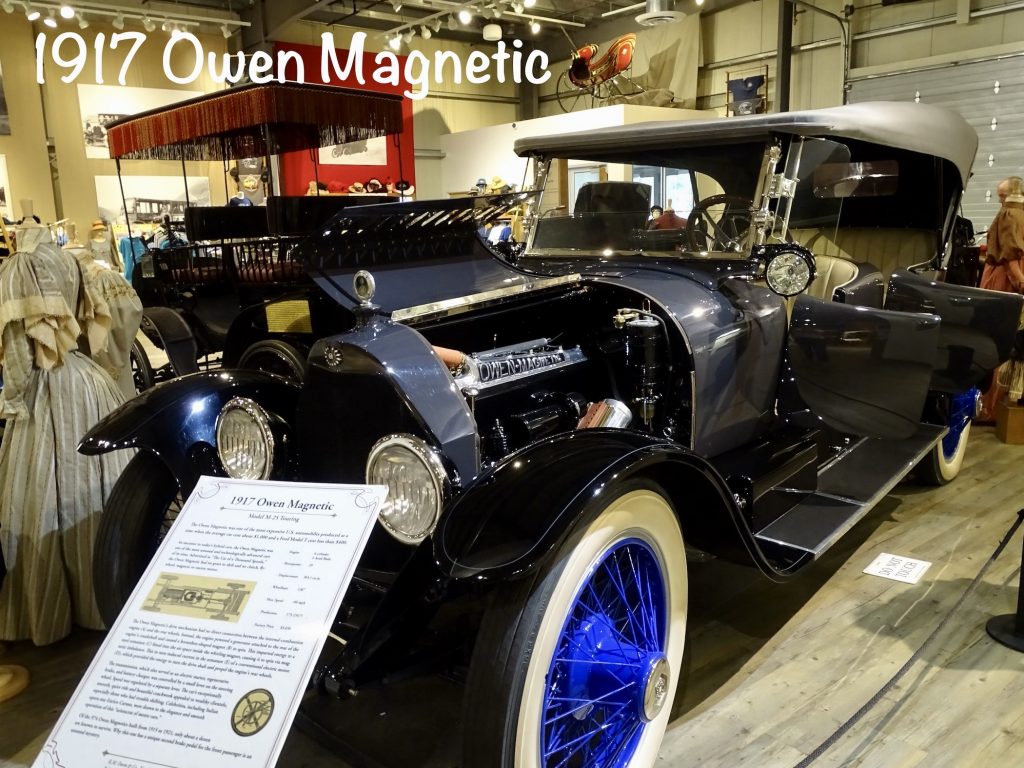











By the time we were done looking at cars, it was time for lunch. Just down the street we found Geraldo’s Restaurant, which was very good Italian and pizza. Then we ran a few errands before heading back to Petunia. I also spent a lot of time in the afternoon writing. Being July 3rd, we talked about the possibility of a fireworks display. Of course, this is Alaska, and there is only darkness for about 5 minutes at 2 AM. And who shoots off fireworks when they can’t see them? Well, apparently, lots of people. That just seems like such a waste of bucks. They did cut it out before too late, though.
Happy 4th of July! Our day started out with a relaxing morning. At some point, we got to hear the wolves howling again, which was just too cool. After getting our acts together, we went to check out the Santa Clause House in North Pole. This is a very large and jam packed, Christmas all year place that really gets the crowds. It is a big deal. I mean, who doesn’t want to go to a Christmas store in North Pole? On our cruise/tour trip to Alaska in 2008, the tour stopped here, too. Today it was overrun, so we didn’t stay long, heading over to the North Pole community fair to see what local craft vendors were there. We also ran into the folks from Moose Creek Baptist Church again. That night there was another invisible fireworks show next door to the campground.





The Fairbanks/Chena River KOA Journey is a typical parking lot of mostly pull-through RV sites that is open from May 15 thru September 15 annually. That said, they have a lot of green spaces and are right on the Chena River. Located about 15 minutes east of Fairbanks, there is easy access to North Pole and anywhere in Fairbanks, plus you can get over to Denali for a day trip in about 2 hours. The staff is very nice and helpful, including accepting mail and packages, and they were very easy with leaving the camper there for our Arctic adventure, something that lots of people do. (Some campgrounds will not let you leave your camper overnight and unattended. ) Amenities include a 24-hour laundry, wifi, a pavilion, dish washing station, camp store, playground, game/book exchange, and dog park. There are also plenty of places to fish, log swings, propane fire pits, lounge chairs, and game areas along the river. There are quite a few RV sites that are a mix of 30- and/or 50-amp pull-thru and back-in. All are full hookup except for two tent/RV sites and 4 tent sites. There were two spotless bathhouses, but there were no picnic tables or fire rings (interior Alaska is almost always under a fire ban during their season). Cell signals for both AT&T and Verizon were strong, and there was lots of over-the-air tv available. Overall this was a good place, as private campgrounds go. Everything is maintained well, and they have seasonal camp hosts that are keeping it all up. For this stay in July 2023, we paid $609.60 for 9 nights. (Unfortunately, I lost my mind and didn’t get pictures.
We are off of our regular travel schedule, so Wednesday was a driving day. We retraced our steps and I napped most of the way back to Delta Junction. Then we continued south on the Richardson Highway down to Copper Center. The weather was clear and beautiful, but very windy, until we got well south of Delta Junction. Then, through Isabel Pass in the Alaska Range, it became overcast very quickly. Thankfully, everything cleared up again on the other side. Before going to the campground, we stopped in at the national park visitor center.












Wrangell-St. Elias is the largest National Park in the United States at 13.2 MILLION acres. That is the same size as SIX Yellowstones, OR Yellowstone, Yosemite, and Switzerland…yes, the country…combined! This rugged landscape is the meeting place of the Wrangell, Chugach, Saint Elias, and the Alaska Ranges, and NINE of the 16 highest peaks in the United States reside within its borders. Mount St. Elias is the second highest peak in the country at 18,008′, and Mt. Wrangell is one of the largest active volcanoes in North America. It butts up to the Kluane National Park in Canada to form a huge wilderness area. The park is also home to the largest sub polar icefield in North America, Bagley, which is the birthplace of the Tana, Miles, Hubbard, and Guyot glaciers. The Malaspina Glacier from the St. Elias Range and the world’s longest interior valley glacier, Nabesna, also live there. The park houses the historic Kennecott mines, too. Driving into this park is just scratching the surface. There are only two roads: 1) Nabesna Road on the north side at Slana, and 2) McCarthy Road at Chitina. Both are unpaved and only go a total of 102 miles in. Aside from a drive in to take a look around, you’ll need to be more adventurous to see this place. Lots of people hike, ski, rock climb, and ice climb. You can hike across Root Glacier or be flown in to do some snowshoeing, skiing, kayaking, or fishing in remote locations. Regardless of how you choose to see it, you can bet the views will be pretty spectacular. The Visitor Center has a really good movie giving an overview of the park and its beautiful, interior scenery, too.

Thursday we headed out early to take one of the drives into Wrangell-St. Elias. It took us about 1-1/2 hours to get to Nabesna Road. On the way, I noticed that my left eye felt odd, and realized that a flippin’ mosquito bit me on the eyelid! Ridiculous!! As previously noted, the road in is dirt that, for the time being, only goes about 30 miles because of a bridge washout. The park ranger at the Visitor Center indicated that the road ran along the treeline, which we thought would mean open views to the mountaintops. That wasn’t the case, but there were plenty of pull-offs with views. After traveling about 18 miles on pretty bad road, it actually got worse. That’s when we decided we had seen enough. It was a peaceful drive, though, with very few other cars and terrific scenery.






Back at Glennallen, we grabbed a few groceries at the IGA, then stopped at The Caribou Grill for sandwiches. While in town we saw the craziest RV rig we’ve ever seen. Back at the campground, I had to bite the bullet and wash some clothes before we had an underwear shortage. With no other options, I had to pay the campground cost of $10 per load! That’s just ridiculous!! I put loads in and set a timer for when to come move it all along. Just before the last two loads were dry, the power went out. It came back on a minute later, and MW walked over to turn both machines back on. About 3 minutes later, it went out again. I walked over to see what the problem was and found a couple in the laundromat asking the same questions. Then I noticed that my load of DAMP clothes was on top of one of the washers. Apparently, the office manager came in while the power was out, assumed that I had left my clothes sitting after they were done, and moved them so she could use the dryer. WHAT?? Did you see where I said they were still damp??? A few minutes later she came walking in and accused us of turning off her clothes before learning that the power was out. Her first response then was to turn to the guy who was working in the breaker box and say: “We need to get this back on. I have laundry to finish!!” She had zero concern for any of the customers. He said the breaker box had to cool down and then we could see if he could turn anything back on. He also said that there was no way he could turn back on all of the electricity, meaning the RVs would be left off. The manager wanted to know what they needed to do to avoid this issue in the future, and he reminded her of an outage in one of the other breaker boxes in 2022. He said the upgrade would cost “tens of thousands of dollars”. Her response: “Well, we can’t do that. I guess we will just tell all of the RVs that they can’t run their air when it gets hot. We’ll just tell everyone from now on.” What??? I don’t have any problem with issues coming up. Crap happens all the time to all of us. BUT…if your plan is to not fix your electrical issues, then charge $60 for full hookup and tell people they can’t use electricity, that’s NOT COOL! After the box finally cooled down a little, he was able to turn power on to the laundromat just long enough for us to finish. Then it was all shut back down. Thankfully, outside temps were just in the mid- to upper-70s, although it was warmer inside. (Amazing that we’ve had temps mostly in the 40s to 60s until there is an electrical problem.) The mosquitoes kept us from sitting around outside, so we headed out to the Princess Wilderness Lodge for supper. The lodge is affiliated with Princess Cruises, and the restaurant was so busy that we ended up eating in the Whistle Stop Bar & Grill. The food and service were very good…MW had fish and chips, and I went with the halibut special…but it was VERY expensive, even by Alaska standards. Back at Petunia, it didn’t really cool off good until after 10 PM or so. We finally got to sleep, but two young children walking outside our window at 11:15 PM woke us both up again. Ugh! Who lets their younguns wander around a campground at that time of night unsupervised?? I’ll just say, I had long since lost my happy face.







While it began in 1896 as an agricultural experiment station, the major growth of the tiny community of Copper Center happened because of the Klondike Gold Rush. In 1898, over 4,000 prospectors landed at Valdez, then made their way up the “Trail of ’98”, which crossed the Valdez Glacier, traversed the Klutina basin and ended up where the Klutina and Copper Rivers meet. Some prospected in the area, while others continued up the Eagle Trail to Forty Mile or Dawson City. Today, aside from the Princess Wilderness Lodge, the community has a few businesses that mostly cater to fishermen, including three RV parks.
Friday we were up and out early to go check out Valdez and, hopefully, see some salmon swimming up the fish ladder at the hatchery. Bears trying to catch them would be icing on the cake!! The drive takes almost 2 hours, and the Richardson Highway ends there. We started out in beautiful weather, but by the time we made it to Richardson Pass in the Chugach Mountains, the ceiling was very low and it was grey, cold, and drizzly. Despite that, it was beautiful. We must have passed 100 waterfalls!!







Our first stop in town was the fish hatchery on Dayville Road. On the way there, I spotted a bald eagle sitting on a rock in Port Valdez. Then MW caught sight of a couple of sea lions on a buoy further out. You could hear them yelling at each other from shore! Then another sea lion hoisted himself up on a different buoy. Too cool! We took the fish hatchery walking tour and were disappointed that the salmon have not made it in yet. That’s why everyone is sitting around waiting! When they do come, there will be a flurry of activity as the water roils with fish and all of the sea birds, eagles, seals, sea lions, otters, bears, and anything else you can think of fight for their share. The Solomon Gulch Fish Hatchery is a spawning ground for pink and coho salmon. Built in 1981, it began releasing fry annually in 1982. Now each year during spawning time about TWENTY THOUSAND fish PER DAY…read that again…will make their way up the ladder, a series of steps and pools, and into the incubator. Then the following spring, around 250 million pink salmon fry and 1.8 million coho salmon smolt start the journey out to the sea to return later and begin the cycle again. Oh, and you might be interested to know that the self-guided tour is open all the time, unless there is a bear on the walkway. LOL








Back in the truck, we headed into town to find the Fat Mermaid for lunch, but they were still serving breakfast. So we walked around the small waterfront area, which is pretty much the life blood of the village. MW remembered that they had a brewery, so we ended up at Valdez Brewing, which got us out of the rain and gave him a chance to sample. Later we walked back over to Fat Mermaid, where we both went for their pretty amazing Red Salmon Sandwich. Next we headed to the end of the bay to check out the fresh seafood offerings at Peter Pan Seafood. As we approached their store, we saw huge buildings, dorms, and a laundromat, all with their logo. Turns out they house an entire crew of people to process the fish they haul in every day. There were lots of people milling around, just waiting for the boats to get back to go to work. I had no idea. On the way out of town we stopped at Captain Joe’s for fuel and to check out the store.








We stopped at the Forest Service Salmon Viewpoint at Crooked Creek to check for salmon with no luck, then drove back down Dayville Road, this time to the end. There we could see where the Alaska Pipeline finally ends. So we traversed the entire length of the 800 mile pipeline in the last couple of weeks. Too cool! Back on the Richardson Highway, we stopped at the Railroad Tunnel of 1906. Back then there were nine companies fighting to build a railroad from the coast at Valdez to the copper mines at Kennecott that we talked about in Wrangell-St. Elias National Park. The competition was fierce, and the feud stopped progress. In the end, an actual gun battle ended the railroad hopes altogether. Seriously??!! All that is left is this tunnel cut into the rock in Keystone Canyon.




Then it was finally time to head over the mountains. The weather cleared up on the other side, but by the time we made it back to Petunia, we were pretty tired. Despite temps only getting to about 78 outside, it was sweltering in the RV. The camp host popped over to let us know that the power was still out and would probably not be restored any time soon. (The owner drove to Anchorage, but couldn’t find the part. The system is really old.) We opened all of the windows and turned on both fans, then headed over to the Old Town Copper Center restaurant, where we hoped it would be a little cooler. The food came out pretty fast, but getting the order in took a while…there was only one woman running her legs off. They make everything from scratch, including the bread, and our sandwiches were pretty darned good. We both took home a little dessert, too. Luckily, it had cooled off nicely when we got back. MW checked in at the office and was given a partial refund for our full-hookups given the situation. With a pretty early start planned in the morning, we pulled in the slide and got everything hooked up to keep from waking up the neighbors. I showered, but had no way to dry my hair. That would make for a really PRETTY look in the morning!!





King For A Day Campground is a definite “no go” for us. That said, if you want to be right on the river to fish, don’t much care about your surroundings, and are okay in a tent, this could be your spot. (Our first clue should have been that their online photo gallery doesn’t have even one pic of the campground, but tons of shots of people holding large salmon.) Sitting right on the Klutina River, this could be a truly fabulous place, but they have settled for mediocre. One of the regulars said “the owner is fairly young and really only interested in fishing, so doesn’t maintain anything”. It seems like someone thought it would be cool to have a campground on the river, but had no idea what it takes to keep one up. Their website says they were awarded the “Best of..” for 2018 and 2019, though. Hmmmm. It is within walking distance of Copper Center, there are good hiking areas nearby, and they run fishing and river rafting trips out of the campground. Amenities include restrooms/bathhouse that are kept minimally clean, a basic laundry (also not terribly clean), and a freezer for anglers to keep their catch. Lodging options included two cabins and the campground. There are tent and dry RV sites, electric only, electric and water, and full-hookup sites available. The latter will not accommodate over about 40′, although MW said there were some sites along the river (not full-hookup) that had plenty of room. The campground is mixed in among the trees, which would be nice, except they have storage RVs crammed EVERYWHERE, some of which look abandoned. Cell signal for Verizon was good, but I didn’t check AT&T, and there was no over-the-air tv. My biggest gripe about this place is the lack of maintenance for big items. The electrical issue while we were there (see above) could easily have caught the building on fire if not discovered, which in turn would have spread to the trees and all of the adjacent RVs…and this is the second year in a row that they’ve had a problem. They charge $60 per night for full hookup and $35 per night for a dirt tent site, $10 for a load of laundry, $420 per person to go fish for a day, and even a few bucks for space in their freezer, but don’t spend the money necessary to fix a serious issue that could hurt people. Instead, their “solution” is to just tell those who pay for electricity that they can’t use much of it. Seeing what could be an amazing place treated poorly is just irritating. For this stay in July 2023 we paid $140 for 3 nights, which includes the $40 refund. Sadly, I think my ire got in the way of taking campground pics. I promise to be better.
Saturday we were up and on the road by 5:45 AM…really! It was going to be a long drive, so we wanted to beat as much traffic as we could. The weather was grey and cold in the morning. I even had to use my truck blanket handmade for me by my little sister, Kate! It ended up staying in the 40s all day. I spent the first couple of hours trying to sleep off a headache. We made it almost to Anchorage before we hit any real traffic, which made MW happy. It wouldn’t be that way for a long ways after that, though. Northeast of town we passed a sign saying “Moose Crash Area”. Apparently there have been 359 moose killed on that little stretch of highway in recent months. None were in sight when we passed through, though. We passed through town and headed south on the Seward Highway, which skirts the Turnagain Arm of Cook Inlet southeast of the city. For lunch, we stopped in at Coast Pizza in Girdwood, Alaska. The food was good, but the stop was a real mistake. Trying to make a left turn back onto the Seward Highway was next to impossible. There was a ridiculous line of traffic turning onto our road, and unlike in the south, no one slowed and waved those of us turning left through It wasn’t until Sunday in a conversation at church that we found out there was a big, annual music festival in Girdwood Friday through Sunday. The preacher said it backed up so far for those turning left that he sat for 45 minutes trying to go straight. Wow! We finally made it to Seward and Miller’s Landing a little after 1 PM. Our site backed right up to the beach, which was beautiful, even in the grey. Within 1/2 hour of getting set up, though, the power went out! Really??!! MW checked the post. It had both 30- and 20-amp plugs at the box, but it was wired with 12 gauge! That is just a problem waiting to happen! He reported it to the office and waited, but nothing happened. Later, on our way out, I checked back in at the office. The guy had put the wrong site number on MW’s initial report, so he promised to get it taken care of while we were gone.
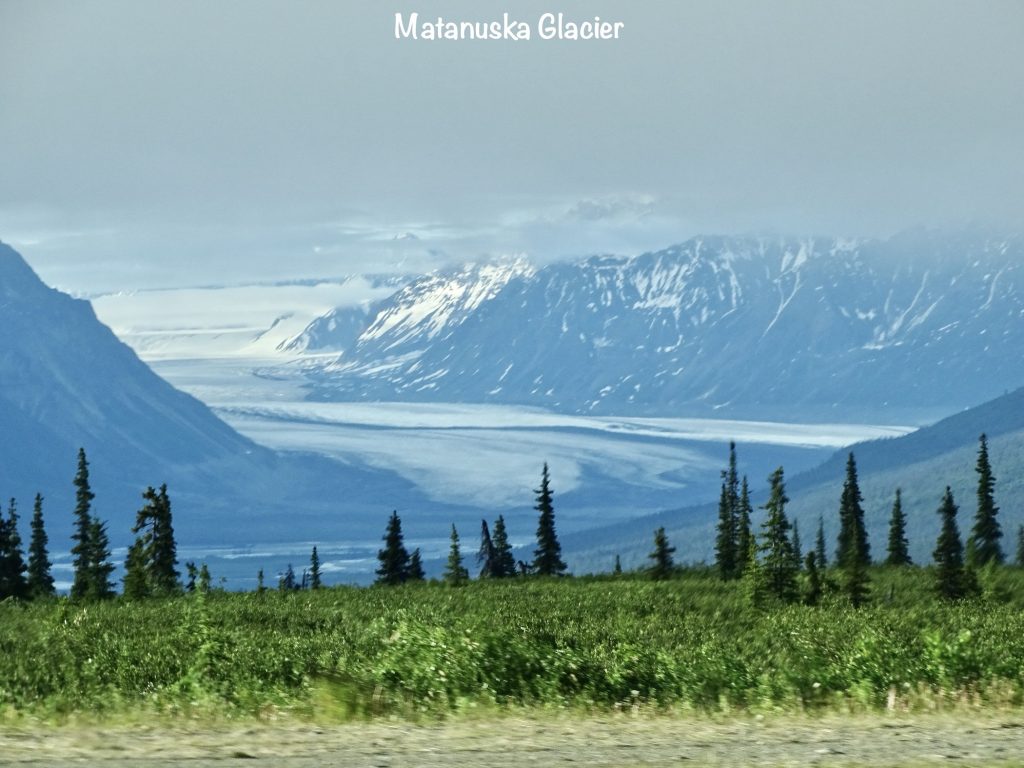








We headed over to the Kenai Fjords National Park Visitor Center, walked around historic downtown Seward checking out the murals, and picked up a few groceries. On the way back to Petunia, we saw a sea otter floating in Resurrection Bay. Cool! (I LOVE otters!) They had been working on the post when we arrived. The park handyman (not an electrician) knocked on the door after a bit and said he was changing out the 20-amp GFCI outlet. That, my friends, is what they call a bandaid. I mentioned the wiring issue, and he said they were aware and had already switched out electrical at all of the other sites. This one was “a little bit more complicated”. Since this site was right by the building, seems like avoiding a fire would be high on the list, but what do I know? Got a little more writing done in the evening.


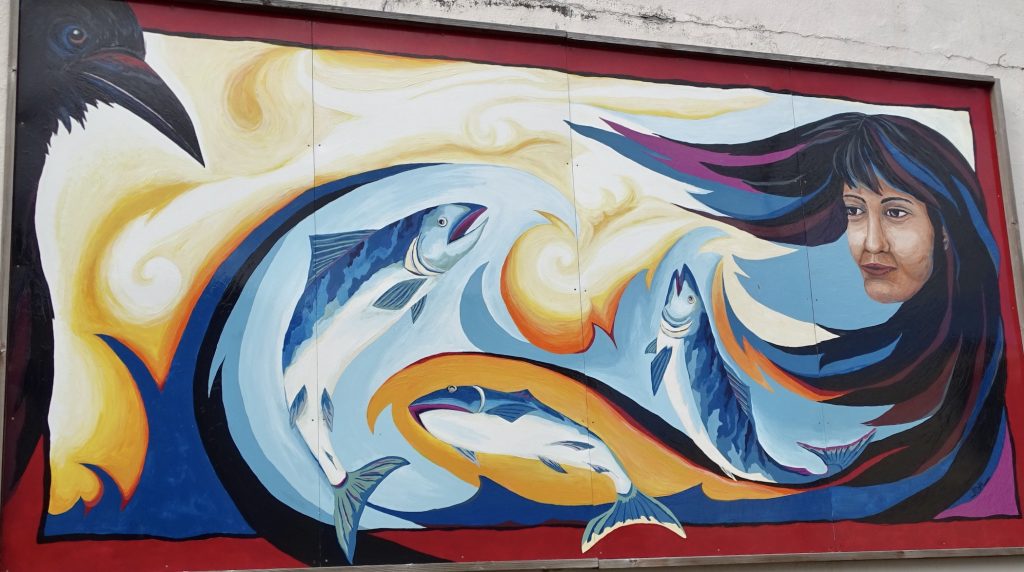




Sunday morning began with a sermon at Resurrection Bay Baptist Church. The regular pastor was away on a mission trip to a fly-in only community in rural Alaska, so their youth pastor, Brandon Davis, took the reins. He gave a passionate sermon about Joseph and the strength of his faith through all of his trials. In it he said something I had not really thought of before: When our faith falters, we can turn to the word of God, but Joseph only had the stories in his memory, passed down from generation to generation. How much harder it must have been in those times to maintain a steady faith in the face of such adversity! Afterwards, we walked over to the Highliner Restaurant for lunch, where I had the best clam chowder I’ve ever eaten. Honest!! We also saw a couple more murals along the way.








Next we walked down to the Alaska SeaLife Center, which was pretty cool. It is a facility for the study of Alaskan marine mammals, birds, and fish, as well as a place to see and learn more about them, and a rescue and rehab hospital. The displays and information were really well done, and I especially enjoyed watching the seals.











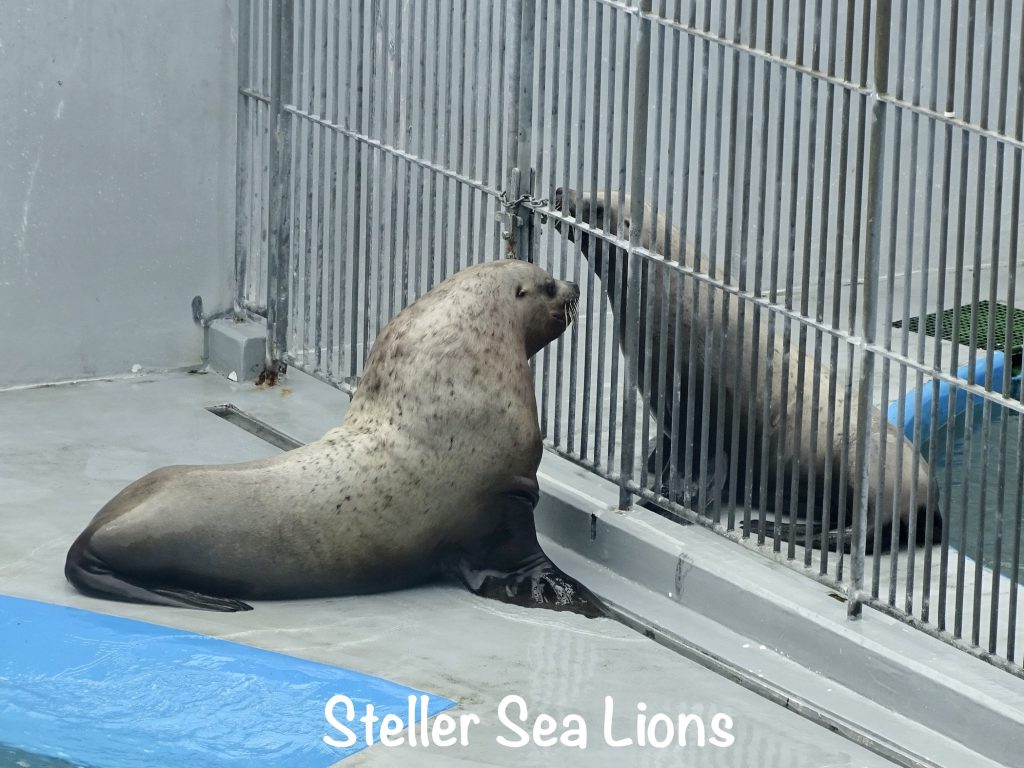






Honestly, I could watch the harbor seals forever, but MW finally drug me out of there. We headed back across the street to Sweet Darlings to check out the fudge, then walked along the waterfront checking out the statues and looking for sea animals. Didn’t see any there, but on the way back to the campground, we saw a sea otter in the water along the roadway.




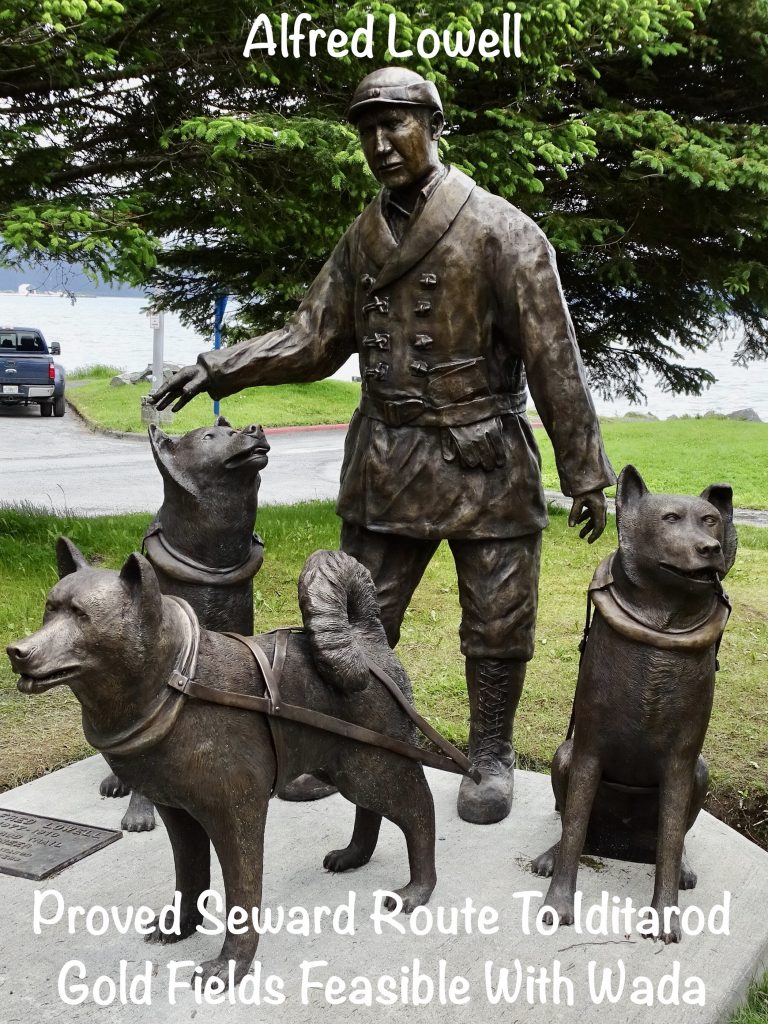











Monday we headed out very early on a grey, damp, cold morning for a bit of exploring. Kenai Fjords National Park runs due north from Bear Glacier Point, then west of Seward up to the Resurrection River. It follows the river for a bit, then a jagged line runs roughly southwest down the Kenai Mountains and turns east back to the ocean at Nuka Bay. All of the islands and inlets from the beginning and ending points are included in the park’s 669,983 acres. More than half of that area is covered by the Harding Icefield and its 38 glaciers. Counterintuitively, the park also includes coastal rainforests. There are plenty of opportunities and methods to explore, but we chose the water approach to see glaciers and, hopefully, sea life. I can’t begin to describe how amazing it was, although I’m certain the two folks onboard who were terribly seasick within the first hour would certainly not think so. (I’ve been there and felt so sorry for them!) The trip was about 8-1/2 hours and went from the marina at Seward out Resurrection Bay to the open ocean, then between the Harris Peninsula and Granite Island up into Northwestern Fjord. We left at 8:30 AM and passed a few fishing vessels heading out for their day. Near the mouth of the bay, we dropped off some people to do a little sea kayaking at a remote beach lodge. The coast here is very rugged with rocky beaches and cliffs that drop right into the water. For the first 1-1/2 hours, we saw a LOT of birds, including several bald eagles. Then, on No Name Island, we spotted a whole bunch of Steller sea lions hanging around at a haul-out spot. These big guys are found from about Northern California all the way up to Alaska in North America and along similar latitudes in Asia. They are the largest of the eared seals, with only a couple of elephant seals and walruses weighing in bigger. (I didn’t even know there were ones with ear flaps and ones without.). About 20 minutes later, someone spotted a whale, but it dove. We waited for a bit to see if it would give us a show, but didn’t see anything. As the boat was continuing on the journey, I happened to look back and catch a glimpse. He was under pretty quick, but I caught some of the blow.















A little bit later, we saw more sea lions hauled out on a rock beach, then a couple of minutes later, saw one of the coolest things of the day…a sea otter eating a red octopus!! No kidding! He would float on his back with the octopus laying up on his belly. Then, when he wanted to clean off, he’d twist around under water, and come back up and start again. It was a pretty big octopus that probably took him a while to finish. I could have watched that one all day. By then we were headed into Northwestern Fjord and things were feeling colder. I was already a bit wet from standing out on the deck taking pictures, too. Every time I’d go inside, though, something cool would show up. The landscape around us was very rugged, and a LOT of ice was showing up on the hillsides. Then we began to see glaciers. I thought the first few were spectacular until we got to end of the fjord. The ones there were a beautiful blue, even with the grey skies. (I didn’t change the color on any of the shots.) So why is it so blue? Just like water, glacial ice absorbs all of the other colors in light…the entire rainbow. Each color has a different wavelength. Think of the arc of a rainbow. The order of the colors doesn’t change. Red is on top and violet is on the bottom. Ice and water are pretty good at absorbing, and hiding, the longer wavelengths, but it can’t quite soak up all that short wavelength violet. So our eyes can see what isn’t absorbed, and it shows up as mostly a turquoise blue. As new snow falls on the glacier, the ice and snow under it become more compressed and push out all of the air bubbles. The ice on top is about the consistency of the ice cubes in your freezer. There is a lot of air, so all of the colors are dispersed and we just see clear. The further down you go, the more dense the ice becomes. It’s got a LOT of heavy stuff above it! As the density changes, the blue can then be seen. That is why when you view a glacier from the side, the slice will be white or light blue at the top and dark blue at the bottom. As Sheldon would say, “We just scienced the crap out of that!”













As we were enjoying the view, the Captain pointed out a section of the glacier and said to keep our eyes on that because “I think it might go.” We watched, and watched, and watched, and watched. A little bit of stuff came off in little sections, but that was it. After several minutes, I was a bit cold and tired of holding up the camera, so I gave up and turned to go sit. Just about that time, someone shouted “it’s going!” Then stuff started coming off in bigger chunks. I managed to catch part of the crash into the water below. It was big enough to create a wave that rocked the boat pretty good, but was not quite as spectacular as the entire column falling in years ago at Glacier Bay.
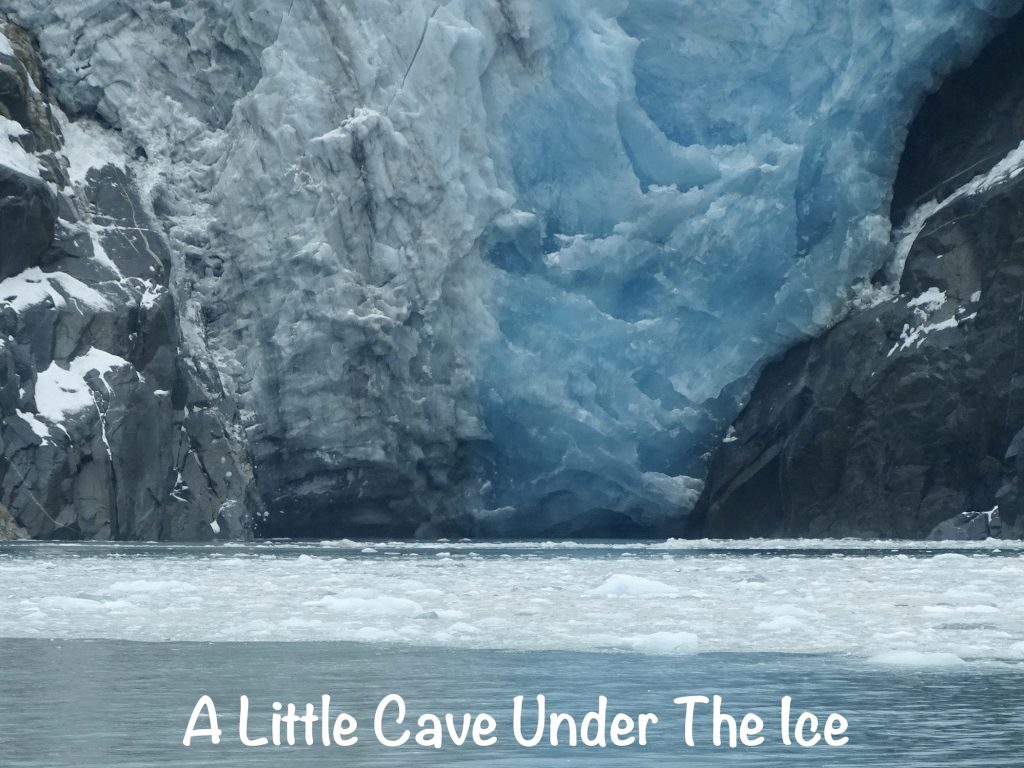





After watching a little bit longer, it was time to head back to port. Just as the Captain turned the boat around, we saw a harbor seal up on a little iceberg. Then a little further down the fjord, we saw an adorable sight…a mama sea otter floating on her back with her baby on her tummy. Too cute!!





By this time I was thinking we’d probably seen most of the cool stuff, but the best was yet to come. As we reached the barrier islands, the Captain pointed out a whole bunch of Steller sea lions! It was a rookery, or a place they go to have their young and mate…in that order. I know. Sounds a little counterintuitive, doesn’t it. The males show up about a week or two before the females to stake out their areas, with the older, larger guys taking up the majority of the space. Then it’s a waiting game…a week or two for the females to show up…time for the females to have their pups… another week or two for them to recover from giving birth…and however long it takes for females to make it into the male’s territory. Then, and only then, does the mating begin. So that poor, female sea lion is pregnant for her whole adult life??? Not exactly. The fertilized egg remains dormant for up to 3 months, which gives her a little break, at least.



After spending a little time getting pics, the Captain pointed the boat north towards Seward. About 10 minutes later just east of Natoa Island, he stopped the boat again. He said he wasn’t sure, but he “thought” we were going to see some whales. The main clue…hundreds of sea birds flocking right above the water. Before we knew it, about 6-7 humpback whales breached the surface, aimed straight up. It is a feeding thing. So when they come upon large schools of fish, they encircle them underwater, then blow air out so the the fish are surrounded by a bubble cylinder. Once they are all compacted into a space, the whales swim to the surface with their mouths open, scooping up dinner along the way. The birds apparently sense or see the fish swirling below the surface and try to get in there to catch their share. I feel certain that some of the birds must be accidentally eaten by whales in the process! After they come up out of the water, they circle around a bit, scooping up scraps, so you see their backs a little. Then they blow and dive with the famous tail shot and start over again. We sat there for about 30 minutes watching them, and I was in awe. I’ve seen orcas hunting seal, but this was a bit more spectacular.
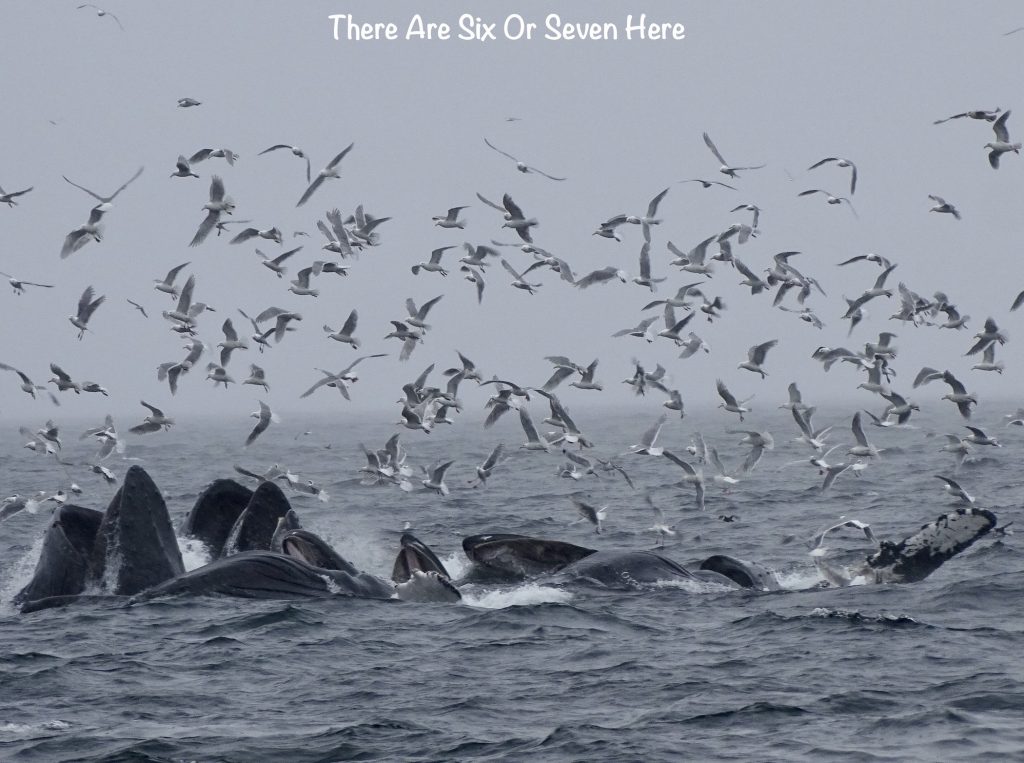











After all of that excitement, we finally headed back to the dock…for real. We debarked about 4:30 PM, and it had been a long, but very exciting day. MW and I checked out the gift shop before walking over to Chinook Seafood & Grill just down the waterfront. Our chicken wraps from lunch had long since worn off, and it was time for supper! MW had the Halibut and Chips, and I had the house salad and clam chowder. It was all delicious, but their claim to be the “best chowder ever” is not correct. I still have to leave that with Highliner that I talked about above. Finally warm and full, we took our worn out butts back to Petunia and relaxed. I slept like a LOG that night!!


If your goal is to back into a campsite right at the water, Miller’s Landing is your place. You can sit out and look across Resurrection Bay, walk along the shore looking for treasures, and watch the sea birds, and if you are lucky, otters, seals, sea lions, or maybe even whales swimming right in front of you. However, parking there is a little like setting up in the parking lot at a really busy mall. Because they offer all types of tours, boat rentals, kayaks, fishing charters, water taxis, etc., there is a constant stream of vehicles coming and going, beginning about 5:30 AM. The parking area is right at the nose of the waterfront sites, so you get constant door slamming, voices, etc. During the day it isn’t so bad, but when you are woken up at 5:30 AM by a small, excited crowd gathered right outside your window for a tour, it is annoying. I would also suggest you not choose site 6. It is the one with electrical issues, plus the kitchen and store staff take their smoke breaks all day long between the building and that site. All that said, there is a lot to do here as noted above. They also offer transportation and customized excursions for groups. Amenities incudes a gift shop, cafe, laundry, bathhouse (very clean with coin operated showers), fish cleaning station, wifi at the store, and boat launch ramp. For lodging they offer a variety of cabins in different sizes, yurts, oceanfront bungalows, duplexes, and inn rooms. In addition to the waterfront campsite, there are plenty of sites in the woods and along the creek, but be prepared for a LOT of mud if the weather is wet. Many have 30-amp hookups and there are fire pits, but water is only available at the fill station. Oh, and the store has free coffee every day, but to empty your tanks, you will need to go to the city dump station in town. Cell signals were strong, but of course, no over-the-air tv stations down there. For us, the crowd was just too much, and we would probably opt to stay somewhere else in the area. For this visit in July 2023, we paid $147.15 for 3 nights.






Tuesday morning we had a side trip planned and headed out about 7:45 AM to dump in town, then hit the road north. The helicopter pilot up at Coldfoot Camp told us that Whittier was a cool little town to visit, so we turned east on Portage Glacier Highway (where you can also access the Portage Glacier) and parked Petunia at the area visitor center.. The town is only accessible by sea, air, or the Whittier Access Tunnel, which is actually an active railroad tunnel that is just wide enough for a train or vehicle. It was too expensive to actually build another tunnel or widen that one, so multi-use means timing is an issue. During the summer, you can go towards town on the 1/2 hour all day between 5:30 AM and 11:00 PM. Traveling out of town is on the hour. (During the winter they shorten the hours to 7 AM to 10:30 PM.) This leaves gaps for trains to get through. MW was a little stressed at us making our 10:30 AM window after being stuck in traffic, but we arrived with a little time to spare. The drive through the tunnel reminded me of when my Dad took us riding down the railroad tracks in his VW bug years ago. (No, I don’t know whether they were active tracks, but I would not put that past him.)






Whittier is a very small community with a full-time population of a little over 200. The area has been used as a route by the Chugach people for generations, and has also seen explorers and prospectors. The town got its start as Army Camp Sullivan during WWII, with the tunnel and railroad spur being completed in 1943. The deep-water port that never freezes, would serve them well in getting material and personnel inland for the defense of Alaska. After the war, the port was temporarily abandoned, but reactivated later during the Cold War. It was finally deactivated in 1960, and all of the wood structures were bulldozed and burned. That left the concrete buildings, some very large. In 1964, an earthquake destroyed just about everything in town EXCEPT those buildings. In 1972, they were purchased by the city and several of those house the majority of the town’s people. There is also a Prince William Sound Museum. The rail yard splits the town in half, so they have a pedestrian tunnel to join the two parts. After parking at the waterfront, we walked through the tunnel and out to the Anchor Inn Restaurant, where many of the locals eat. Then we walked along the waterfront, where there are a few shops to check out. Whittier is a beautiful little seaport, which would have been better in the sunshine, but you take what you get. There is a nice hotel, and they run fishing tours and water activities from the marina. After taking it all in, we headed back to Brutus to make the outgoing tunnel time slot.












Back on the other side of the mountain, we headed back to the Begich, Boggs Visitor Center, where Petunia was parked. Before hitting the road again, we looked around inside and took in the movie about the Chugach National Forest and the glaciers in the park, including the Explore, Middle, Byron, Portage, and Burns. The building is actually built on the terminal moraine from the glacier, which is the furthest out it has ever been and where all of the rock and debris from the advance is deposited. There are native Alaskan, animal, and geography exhibits, and the movie is very good. Oh, and if I haven’t said this before, the National Park Service has now put out the free, lifetime Veteran Pass. Too cool! We checked it all out, then hit the road for Anchorage and ended up at the Golden Nugget RV Park by about 3:30 PM.





SIDE STORY: In the museum there was the story of a prospector named HarryJohnson. In the Spring of 1908, Harry was prospecting north of Seward, Alaska. One day when he was climbing up the side of a mountain, he saw a bear in the bushes. Without any weapons, he carefully withdrew behind some trees, where he turned right into the mama bear. She knocked him down and mauled him pretty good, mainly in the back and arm. He managed to roll away into some bushes, and she wandered off. She wasn’t done, though, and came back for more. When she finally left him alone, he was bloody and a bit torn, but miraculously, no bones were broken. Harry crawled down the mountainside to his tent on the creek. After assessing the situation, he picked himself up and began walking to Seward, about 20 miles away. He walked for 15 miles, then ran into two men who put him on a cart and took him the rest of the way. By the next morning, Harry was stiff and sore, but otherwise fine. Wow! That’s some pluck, right there!
After all of the early mornings, long drives, and activity of the past week, our goal in Anchorage for Wednesday through Saturday was relaxation. We sat around a good bit, but we also ran some errands…Costco, Michael’s, Bass Pro Shops, Home Depot, groceries. I took Brutus for a much needed wash, mainly to get the caked on mud off of the running boards that ended up on my pants every time I got in or out. It was also way past time for a haircut, so I went to a place recommended by the campground office…and got butchered! (I really should have just walked out when she barely spoke English and kept saying “yes, yes”. It will only be annoying until it grows out, though.) On Thursday we had lunch at F Street Station, the oldest downtown Anchorage bar still in its original location and the second oldest overall. (MW had a crab sandwich and onion soup, and I went for the clam chowder and sautéed scallops and shrimp on pasta. It was ALL excellent!) We also scouted for laundromats, which were ridiculously expensive. Thankfully, there was one at the RV park that was very reasonable. Then Friday, after I took care of the laundry, we ate at Fletcher’s at Hotel Captain Cook. When we walked into the hotel, I had a bit of déjà vu. After seeing a few pieces of artwork, it dawned on me that we stayed there during our cruise tour back in 2008. The restaurant had a really nice, pub atmosphere, and the food was excellent (chopped salad and seafood chowder for me and reuben for MW). We also stopped in at Eva’s Cupcakery, where we bought some delicious cupcakes and had a nice conversation with the owner. She is from Alabama and seemed like the nicest lady. Finally, on Saturday I headed out to take a few mural pics downtown and find a place to write for a while.










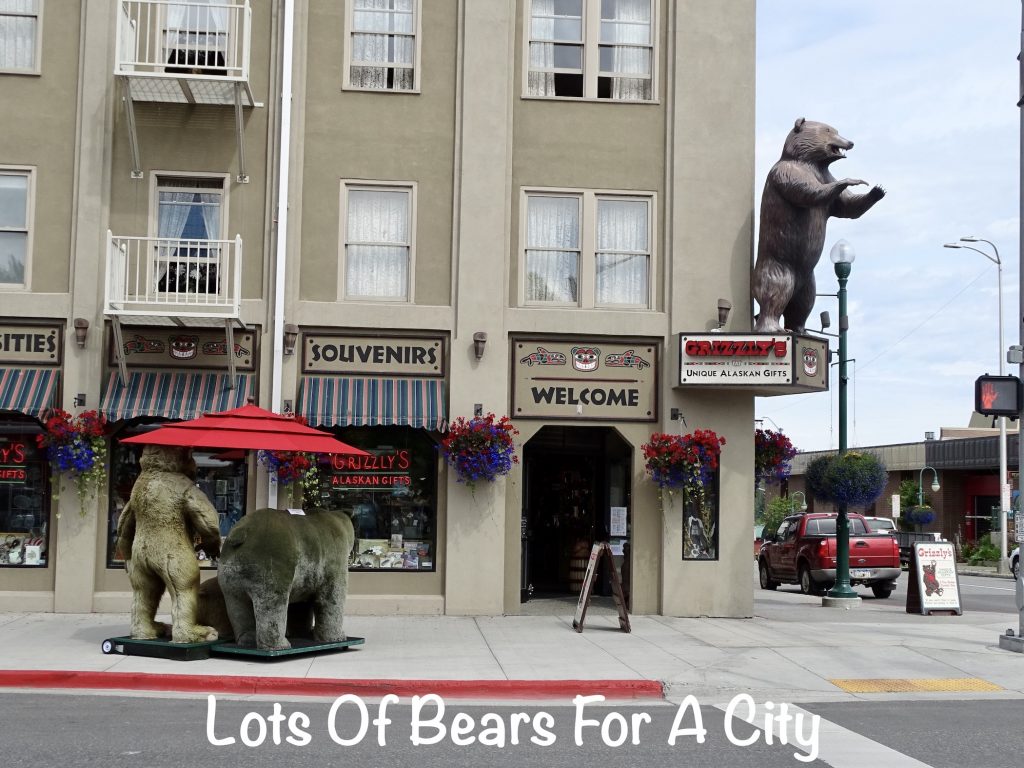






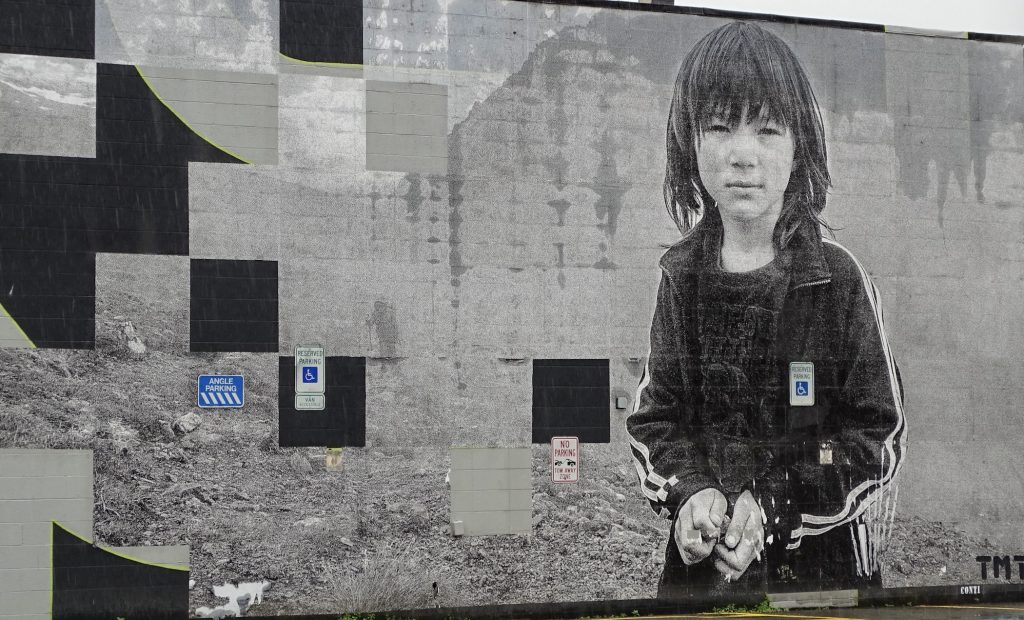
Golden Nugget RV Park is your typical, city RV lot. Right in town on the northeast side of Anchorage, it is convenient to all of Anchorage including the Alaska Wildlife Conservation Center south of town. The staff is very friendly and the facilities are well kept, but there is quite a bit of vehicle noise. (Honestly, it sounded like drag racing up and down adjacent Debarr Road in the middle of the night.) Facilities include a limited store at the office, restrooms/showers that were very clean, a large laundromat, and picnic area. There is also a park right across the side street with a large playground and dog walking area. The campground has 215 sites in a variety of 30- and 50-amp, back-in and pull-through, all with picnic tables. There was wifi in the park, cell signals were very strong, and there was plenty of over-the-air tv. For a city park, it wasn’t bad, albeit expensive. We would stay again if in the area. For this stay in July 2023, we paid $350 for 5 nights. No pics for this one, but just imagine a large, gravel parking lot with RVs side-by-side.
Whew! That was a LOT! Next up…the BIG mountain and starting the return. See you on the path!
Talisa
P. S. Thank you so much for reading! Use the buttons at the top right or bottom to be notified of new posts, and please SHARE, SHARE, SHARE on social media!
Talisa

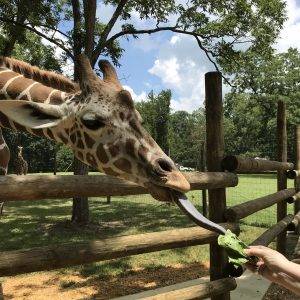
Leave a Reply